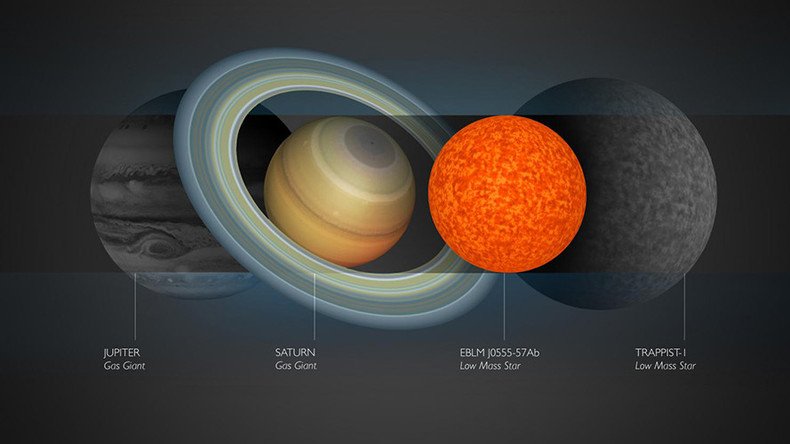Newly-discovered star could not possibly be any smaller – study

University of Cambridge astronomers have stumbled upon the smallest star ever discovered. Fractionally larger than Saturn but smaller than Jupiter, it was hiding in a binary star system 600 light years away.
The gravitational pull of the star, with the catchy name EBLM J0555-57Ab, is about 300 times that of what we feel here on Earth. Researchers believe it’s likely to be as small as stars can be, and was found while astronomers were hunting for planets.
'Fascinating discoveries': #NASA telescope reveals secrets of #TRAPPIST1 exoplanets https://t.co/1fYCqDqclepic.twitter.com/PEV9dLVybt
— RT (@RT_com) May 23, 2017
Stars need to have enough mass to allow for the fusion of hydrogen nuclei into helium. If not, they will most likely collapse in on themselves becoming so-called brown dwarfs.
“Our discovery reveals how small stars can be,” Alexander Boetticher, lead author of the study, said in a press release. “Had this star formed with only a slightly lower mass, the fusion reaction of hydrogen in its core could not be sustained, and the star would instead have transformed into a brown dwarf.”
Brown dwarfs are stellar objects which just don’t quite manage to make it as stars and aren’t quite planets.
‘False positives:’ More than half of NASA’s Kepler exoplanets aren’t actually planets https://t.co/ZfkBoJoIEapic.twitter.com/INyij2Kbvv
— RT (@RT_com) December 6, 2015
The star was discovered while boffins were searching for exoplanets during the Wide Angle Search for Planets (WASP) experiment, a collaboration of six UK and two Spanish universities.
Astronomers first thought EBLM was a planet, but concluded it was indeed the tiniest star ever discovered after it passed in front of its parent star forming what is called an “eclipsing stellar binary system.”
“This star is smaller, and likely colder than many of the gas giant exoplanets that have so far been identified,” said Boetticher. “While a fascinating feature of stellar physics, it is often harder to measure the size of such dim low-mass stars than for many of the larger planets.”
“Thankfully, we can find these small stars with planet-hunting equipment, when they orbit a larger host star in a binary system. It might sound incredible, but finding a star can at times be harder than finding a planet.”
#7NamesFor7NewPlanets: NASA looks for help naming new discoveries, #internet obliges https://t.co/rgTT3VqTHRpic.twitter.com/1fqAkPsy8z
— RT (@RT_com) February 26, 2017
Although it has a radius nearly one third smaller, EBLM has a mass that is comparable to that of Trappist-1, a recently-discovered dwarf star harbouring seven exoplanets, three of which are in the star's ‘habitable’ or ‘goldilocks’ zone thought to have the perfect conditions to sustain life.
“The smallest stars provide optimal conditions for the discovery of Earth-like planets, and for the remote exploration of their atmospheres,” said study co-author Amaury Triaud. “However, before we can study planets, we absolutely need to understand their star; this is fundamental.”












